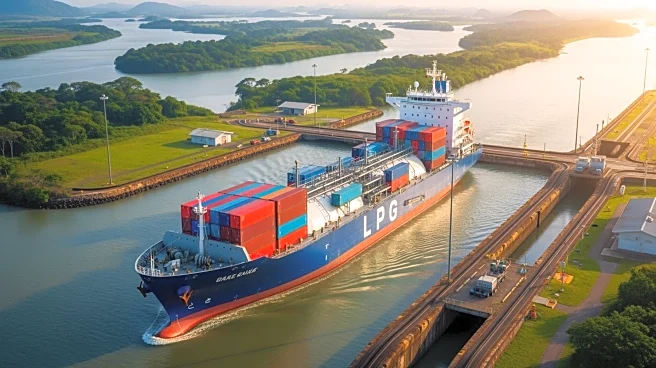What's Happening?
The Panama Canal Authority is anticipating an increase in liquefied petroleum gas (LPG) vessel transits to counteract a projected decline in global trade. The canal, which connects the Pacific and Atlantic
oceans, reported a 14% revenue increase to $5.7 billion in the last fiscal year, with a 19% rise in transits, largely driven by LPG vessels and container ships. Ricaurte Vasquez, the administrator of the Panama Canal Authority, highlighted the growing importance of LPG, predicting its value will rise over the next two decades. The canal's share of U.S. LPG exports to Asia has rebounded to over 95%, recovering from a previous dip due to drought-induced passage restrictions. The Authority is also exploring the construction of a 2-million-barrel-per-day LPG pipeline in the canal zone, slated for completion in 2030, to further capitalize on this market.
Why It's Important?
The Panama Canal's strategic focus on LPG transits is significant as it seeks to offset a forecasted revenue decline due to reduced global trade. The canal's ability to maintain and grow its share of U.S. LPG exports to Asia is crucial for its financial health, especially in light of recent trade policy changes and tariffs that have increased canal traffic. The proposed LPG pipeline could enhance the canal's capacity to handle increased LPG volumes, attracting more U.S. companies and potentially boosting the canal's revenue streams. This shift towards LPG and agricultural commodities could stabilize the canal's operations amid fluctuating global trade dynamics.
What's Next?
The Panama Canal Authority is in the process of selecting companies to build and operate two new ports within the Canal Zone, with completion targeted for 2029. Additionally, the Authority is advancing the Rio Indio reservoir project, expected to secure freshwater for the canal by 2031. These infrastructure projects, requiring an $8.5 billion investment over the next decade, are critical to the canal's long-term sustainability and capacity to handle increased traffic. The canal's strategic initiatives could influence shipping routes and trade patterns, particularly for U.S. exporters and Asian importers.












